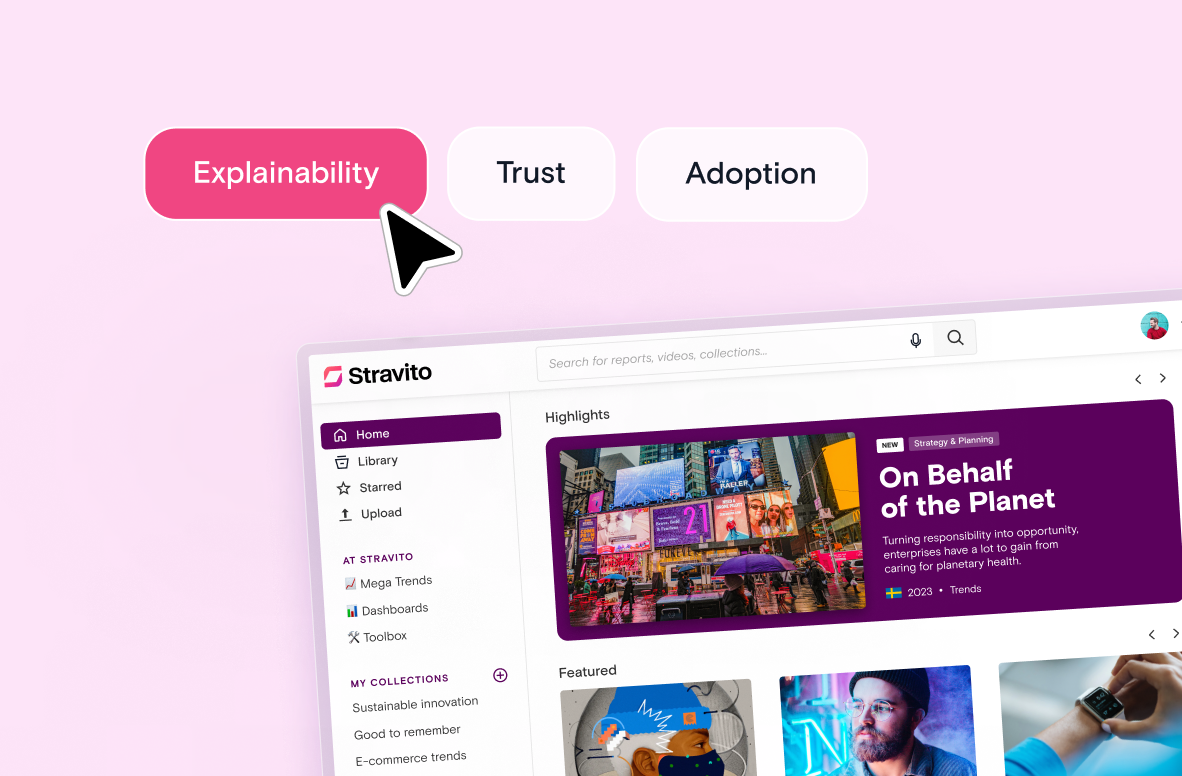TL;DR:
- The principles of knowledge management help you turn scattered research into decisions that drive growth.
- Modern KM is about alignment, access, and adoption that scales across teams.
- AI now supports discovery, but people still shape meaning and context.
- A few core principles can boost reuse, reduce rework, and prove ROI fast.
- You’ll leave with a 30-day playbook to apply knowledge management principles in your business.
You’ve built strong insights and research functions. Now it’s time to connect them through a system where knowledge actually moves the business forward.
Leading enterprises see knowledge as a living system that drives performance. They connect insights to business value, focus on usage over volume, and make discovery simple for every employee.
The 12 core principles of knowledge management show how to make that mindset real in your organization.
If all your teams had fast, trusted access to the knowledge they need, what could your business do differently tomorrow?
Why knowledge management principles matter more than ever
Every team deserves to find what they need in seconds. When knowledge is easy to access and clear in context, better decisions follow naturally.
What these principles achieve
- Speed. Teams find the right knowledge instantly, even across markets and systems.
- Trust. Everyone works from the same facts and validated research.
- Scalability. Insights grow with your business instead of getting lost in it.
- Clarity. Each knowledge asset has purpose, ownership, and links to decisions.
Why this matters in 2026
A solid knowledge management framework ensures that automation supports judgment. Your repository stays clean and searchable, and knowledge sharing becomes second nature.
These knowledge management principles strengthen organizational knowledge. They help you balance tacit knowledge and explicit knowledge while protecting intellectual capital. They also improve knowledge capture and support continuous learning as teams change.
If you’re planning the next phase, align your knowledge management strategy with a simple, staged knowledge management implementation.
When you treat knowledge management as a system guided by principles, not just technology, you make knowledge a valuable asset for decision-making.
The 12 core principles of knowledge management
Knowledge management works when it’s guided by clear principles. They turn scattered information into usable insight that drives action and collaboration.
Strategic alignment and value creation
Start with alignment. Link every project to clear business outcomes so teams stay focused, confident, and connected to the organization’s goals.
1. Value alignment
Identify three to five high-impact decisions your organization makes each quarter, such as pricing, innovation, or product development.
To apply this principle:
- Map the required knowledge assets to each decision.
- Assign owners who can keep content current and relevant.
- Review whether each asset supports measurable business outcomes.
2. Reuse before re-research
Before starting new research, review what already exists. Encourage a “search first” policy and flag duplicate studies to reduce waste.
This habit strengthens your knowledge management processes and keeps insights flowing across functions instead of getting lost in silos.
3. Measurable outcomes
Define what success looks like. You can measure impact through:
- Reuse rate and avoided research spend.
- Time saved in decision-making.
- Improved employee satisfaction with knowledge accessibility.
Tie these outcomes directly to your knowledge management strategy so you can prove business impact.
Accessibility and usability
Once the value is clear, the next step is access. Knowledge only works when people can find and use it easily, no matter where they sit in the business.
4. Unified and searchable knowledge
Unify access to all repositories through one layer of search. Index, deduplicate, and apply a consistent taxonomy to ensure every user can find relevant information quickly.
A modern AI knowledge management system supports this by connecting insights from multiple platforms into one accessible experience.
5. Lowest friction wins
Make sharing and discovery effortless. Templates, auto-tagging, and drag-and-drop uploads simplify contribution and reduce resistance.
Practical ways to lower friction:
- Automate tagging and metadata where possible.
- Use standard templates for report uploads.
- Integrate contribution directly into the tools your teams already use.
6. Context over content
Content only matters when people know how to use it.
To make context clear:
- Add “why it matters,” “when to use,” and “who it helps” to every artifact.
- Link related assets together for easy navigation.
- Keep summaries short so users can scan quickly.
This gives your organization the clarity to turn static information into actionable insight and keeps your knowledge repository relevant over time.
Governance and trust
Good systems rely on trust. Governance gives teams confidence that what they find is accurate, secure, and ready to use.
7. Curation and governance
Assign clear ownership for every knowledge collection.
Good governance includes:
- Defined review cycles and expiration dates.
- Archiving outdated material to reduce clutter.
- Using a knowledge management framework to set standards for structure, access, and quality.
Regular maintenance ensures your information stays accurate, updated, and useful.
8. Security and trust by default
Trust grows when information is protected. Apply role-based permissions, retention rules, and audit trails.
Responsible knowledge management implementation prevents misuse and builds confidence that sensitive data stays secure.
Human and AI collaboration
AI speeds discovery, but people create meaning. The goal is to combine both so automation supports human judgment, not replaces it.
9. Human and AI collaboration
Use AI for discovery, summarization, and synthesis, but keep human validation at the center.
The best AI knowledge management solutions combine automation with expert oversight. This balance ensures reliable knowledge creation, not just information retrieval.
10. Continuous improvement
Treat your knowledge system like a living product.
A practical approach includes:
- Gathering user feedback regularly.
- Tracking search gaps and refining taxonomy.
- Updating navigation and processes based on behavior data.
Continuous improvement keeps processes relevant and responsive to user needs.
Culture and engagement
Even the best systems fail without participation. A strong culture turns knowledge sharing into a habit that connects teams and builds momentum.
11. Socialization and storytelling
Promote a strong knowledge-sharing culture by showcasing insights through newsletters, feeds, or short updates.
When teams closest to the customer share stories and experiences, they strengthen collective understanding and make organizational knowledge easier to apply.
12. Continuous learning
Encourage people to learn, teach, and capture lessons in real time.
To strengthen continuous learning:
- Build feedback loops after each major project.
- Capture lessons learned before moving to the next phase.
- Reward knowledge sharing to reinforce positive behavior.
Continuous learning and reflection expand your base of tacit knowledge and explicit knowledge, making your organization more resilient as people and projects change.
Together, these key principles of knowledge management support a sustainable approach to capturing, organizing, and distributing knowledge. They make your business more adaptable, measurable, and ready for what’s next.
Here’s how you can apply them step by step over the next 30 days.
How to apply these knowledge management principles in 30 days
You don’t need a long implementation project to improve how your organization manages knowledge. By focusing on small, high-impact actions, you can demonstrate effective knowledge management within weeks.
This 30-day playbook helps you enable organizations to build better habits and see results fast.
Week 1: Align knowledge to business decisions
Start by connecting your most important business decisions to the knowledge that supports them.
- Choose three high-value decisions, such as launch planning, market expansion, or product innovation.
- Map the required knowledge assets and identify any gaps in your organization’s knowledge.
- Document how each piece of information contributes to problem-solving and measurable results.
Managing knowledge this way makes your system a critical decision-making tool, not just a central repository of reports.
How you’ll know it’s working:
Leaders start to see how knowledge transfer drives performance, and teams understand how insights support strategy.
Week 2: Improve search and knowledge organization
Make knowledge easier to find and reuse.
- Review your current search logs and fix zero-result queries.
- Create a clear taxonomy and tag structure that reflects how most organizations search.
- Apply machine learning or AI tools to suggest related terms, synonyms, and categories.
These updates make your repository easily accessible and ensure that knowledge depends on structure, not memory.
When discovery improves, you’ll notice more collaboration and faster access to the right knowledge.
How you’ll know it’s working:
Employees find information in seconds, feedback improves, and duplicate work declines.
Week 3: Curate and refresh high-value knowledge
Now that you’ve improved findability, focus on quality control and retention.
- Review your top 50 most-used assets and remove outdated files.
- Add short summaries and note which teams closest to the customer rely on them.
- Apply organizational retention policies so valuable information stays secure and current.
If you already use Stravito, automated ingestion and deduplication simplify this process. Curating a quality-controlled set of assets strengthens trust and protects intellectual capital.
How you’ll know it’s working:
Your knowledge repository feels lighter, confidence rises, and new users quickly grasp how to locate what they need.
Week 4: Socialize insights and build a sustainable approach
Once your system feels cleaner and easier to use, focus on continuous learning and engagement.
- Share insights through newsletters or team feeds to support knowledge-sharing culture.
- Encourage experts to contribute tips and examples of best practice.
- Recognize and empower employees who model strong sharing behaviors.
This social process turns static information systems into dynamic spaces that distribute knowledge across the business. It helps retain tacit knowledge and fosters the skills needed to sustain growth.
How you’ll know it’s working:
Insights circulate naturally, collaboration improves across functions, and leadership begins linking outcomes to your knowledge management principles.
By the end of 30 days, you’ll have a highly structured knowledge environment that supports reuse, trust, and measurable business value.
You’ll also have early benchmarks to guide further developing and scaling your knowledge management implementation.
With this strong start, let's make sure your teams don’t fall into the traps that slow most initiatives down.
Keep your momentum: common challenges and how to move past them
Every organization faces roadblocks when managing knowledge at scale.
The key is to spot them early and turn them into opportunities for improvement. These are the areas where even experienced teams can lose traction and how to keep moving forward.
Challenge 1 - Treating knowledge management as a one-time project
Knowledge management isn’t a “set it and forget it” initiative. It’s an evolving practice that depends on continuous learning and user feedback.
How to move past it:
- Treat your system as a living product. Review metrics, update workflows, and release small improvements regularly.
- Invest in the right skills and roles so ownership doesn’t fade after launch.
- Celebrate quick wins that prove effective knowledge management creates lasting value.
Challenge 2 - Over-engineering your structure
Many teams try to control every folder, tag, and rule from day one. This slows progress and discourages contribution.
How to move past it:
- Start simple. Build around how people already search and work.
- Use analytics to refine your taxonomy over time.
- Remember that the real advantage lies in usability, not complexity.
Challenge 3 - Confusing storage with strategy
A large library doesn’t always equal progress. Without context and governance, your repository becomes cluttered and hard to trust.
How to move past it:
- Focus on relevance, not volume. Archive what’s outdated.
- Make every asset purposeful by adding “why it matters” and “how to use it.”
- Reinforce that knowledge is a valuable asset, not just a document.
Challenge 4 - Forgetting the human side
Even the smartest system fails without engagement. People need motivation and confidence to share what they know.
How to move past it:
- Build a culture that supports knowledge sharing and rewards contribution.
- Empower employees to contribute expertise in their own knowledge spaces.
- Provide gentle guidance for new users so managing knowledge feels natural, not forced.
Challenge 5 - Ignoring measurement and evolution
Without clear indicators, it’s hard to show progress or secure long-term support from executive management.
How to move past it:
- Track simple metrics: reuse rate, participation, and time saved.
- Use these results to demonstrate ROI and secure continued investment.
- Keep leadership informed on how insights are improving decisions.
By staying focused on progress instead of perfection, you’ll keep building trust, engagement, and measurable impact.
Every improvement compounds over time, and that’s what makes knowledge management sustainable.
How Stravito helps with knowledge management
Consistency turns principles into progress. Stravito helps your teams put that consistency into daily practice.
Where most tools stop at storage, Stravito turns knowledge into action. It’s built for Insights, Research, and Strategy leaders who want effective knowledge management without the complexity of traditional systems.
Built around real business decisions
Stravito connects research, reports, and insights to the decisions they support.
How it works:
- Centralizes global and local research in one searchable layer
- Links studies directly to business goals like launch planning or portfolio strategy
- Surfaces relevant insights in seconds with built-in AI summaries
Companies like Reckitt use Stravito to link thousands of studies to strategic priorities. By surfacing the right knowledge at the right time, teams spend less time searching and more time acting.
You can see this approach in action through knowledge management for your research.
Easy to adopt, simple to scale
Enterprise systems often fail because they’re too hard to use. Stravito changes that.
Key features that drive adoption:
- Drag-and-drop uploads with automatic tagging
- Instant AI summaries for faster understanding
- Simple, intuitive search across all repositories
HEINEKEN uses Stravito to democratize insights across global markets. The platform helps teams reuse existing research, reduce duplicate projects, and improve knowledge transfer between functions.
Designed for trust, speed, and scale
Stravito’s framework supports both secure governance and fast collaboration.
Built for large organizations:
- Role-based permissions and audit trails
- Version control to maintain accuracy
- Secure sharing that balances compliance with accessibility
Roche uses Stravito to standardize its global knowledge management framework. The result is a trusted system where information flows safely, and collaboration continues without bottlenecks.
You can explore more in the Stravito guide to knowledge management.
Your next steps
You’ve seen how the principles of knowledge management translate into real business results. Here’s how to keep building momentum:
-
Assess your foundation.
Review your current system. Identify gaps in usability, governance, and engagement. -
Prioritize what matters most.
Focus first on high-impact areas such as research reuse, faster decision making, and global collaboration. -
Put principles into practice.
Start applying what you’ve learned. Then scale with a platform that supports structure and simplicity.
Ready to see it in action?
Stravito helps you create a culture where knowledge flows freely, decisions move faster, and every insight adds measurable value.
Now, it's time for you to turn your organization’s knowledge into a true competitive advantage.
Request a Stravito demo and see how effortlessly your teams can find, share, and use insights that drive growth.
FAQs
What are the key principles of knowledge management?
The key principles of knowledge management include alignment with business goals, accessibility, governance, collaboration, and continuous learning. These ensure knowledge is shared, trusted, and used across teams.
Why is knowledge management a valuable asset for enterprises?
Knowledge management is a valuable asset because it turns insights into action. When organizations manage knowledge well, decisions become faster, innovation increases, and expertise is never lost.
Where do knowledge management responsibilities lie?
Knowledge management responsibilities lie with both leadership and teams. Executives set strategy, while contributors maintain accurate, searchable, and secured knowledge.
How does Stravito support effective knowledge management?
Stravito simplifies managing knowledge through intuitive search, AI summaries, and secure governance. It enables organizations to create accessible knowledge systems that scale globally.
How can we measure success in knowledge management?
Measure progress by tracking knowledge reuse, search success, and time saved in decision-making. These metrics show how effective knowledge management delivers real business value.




